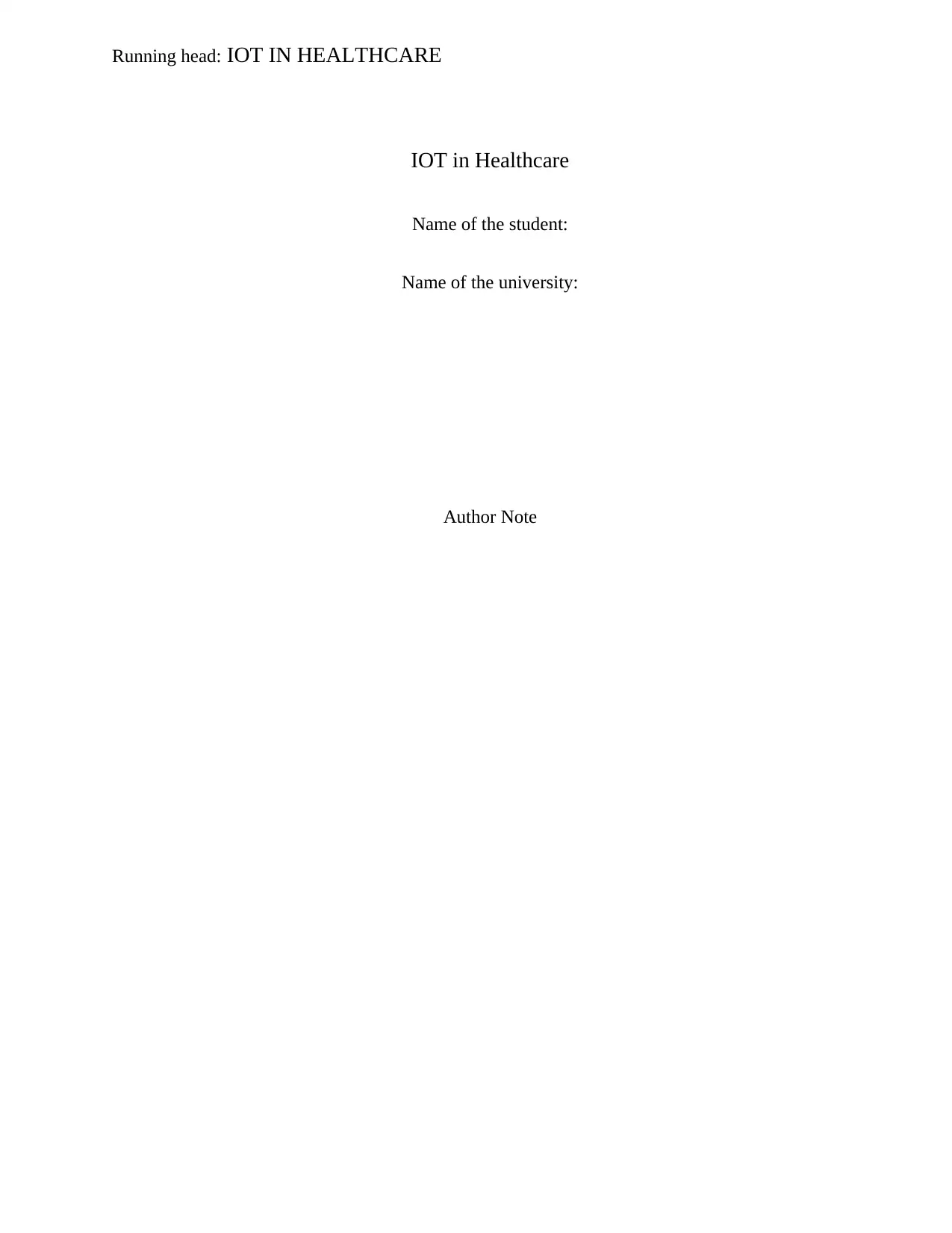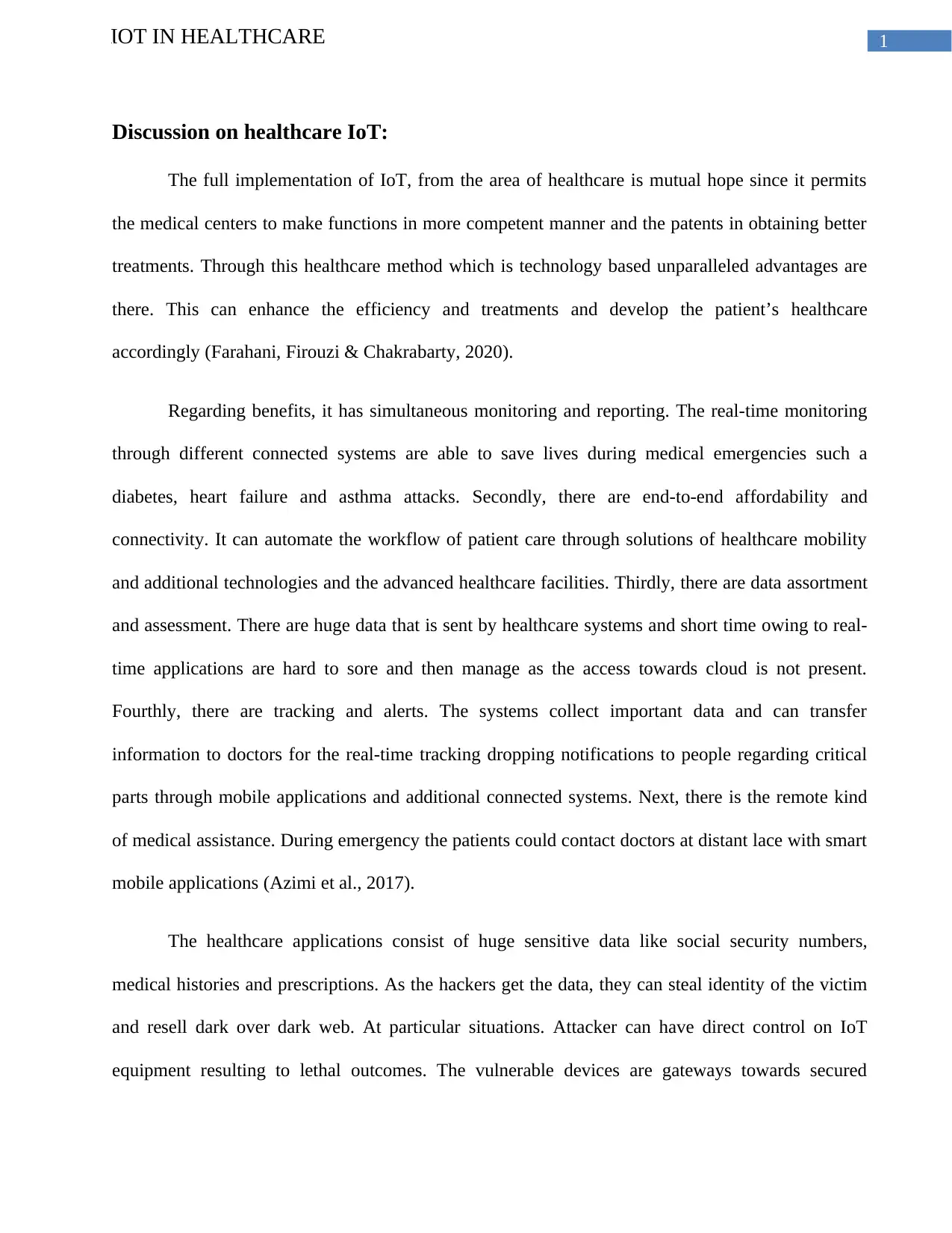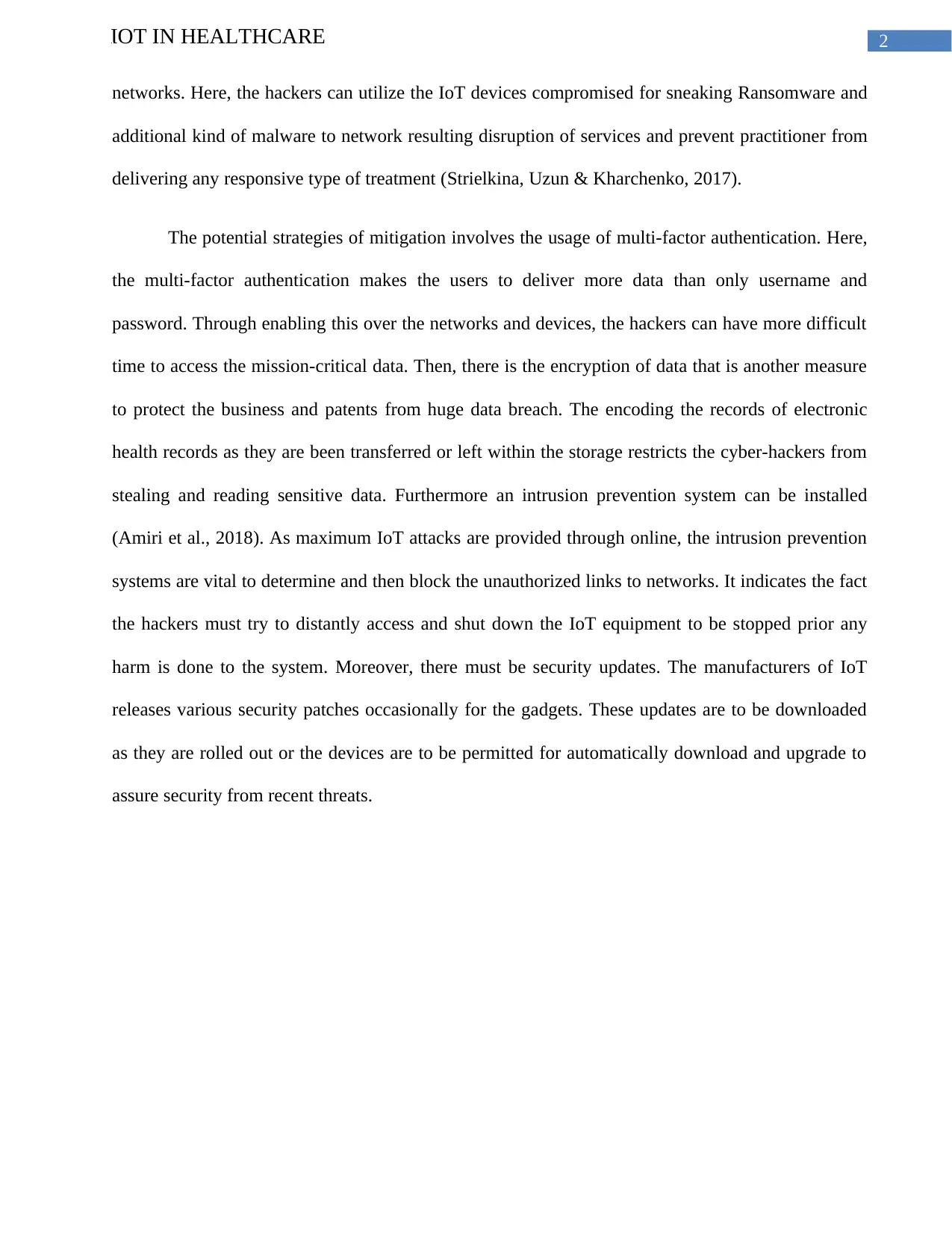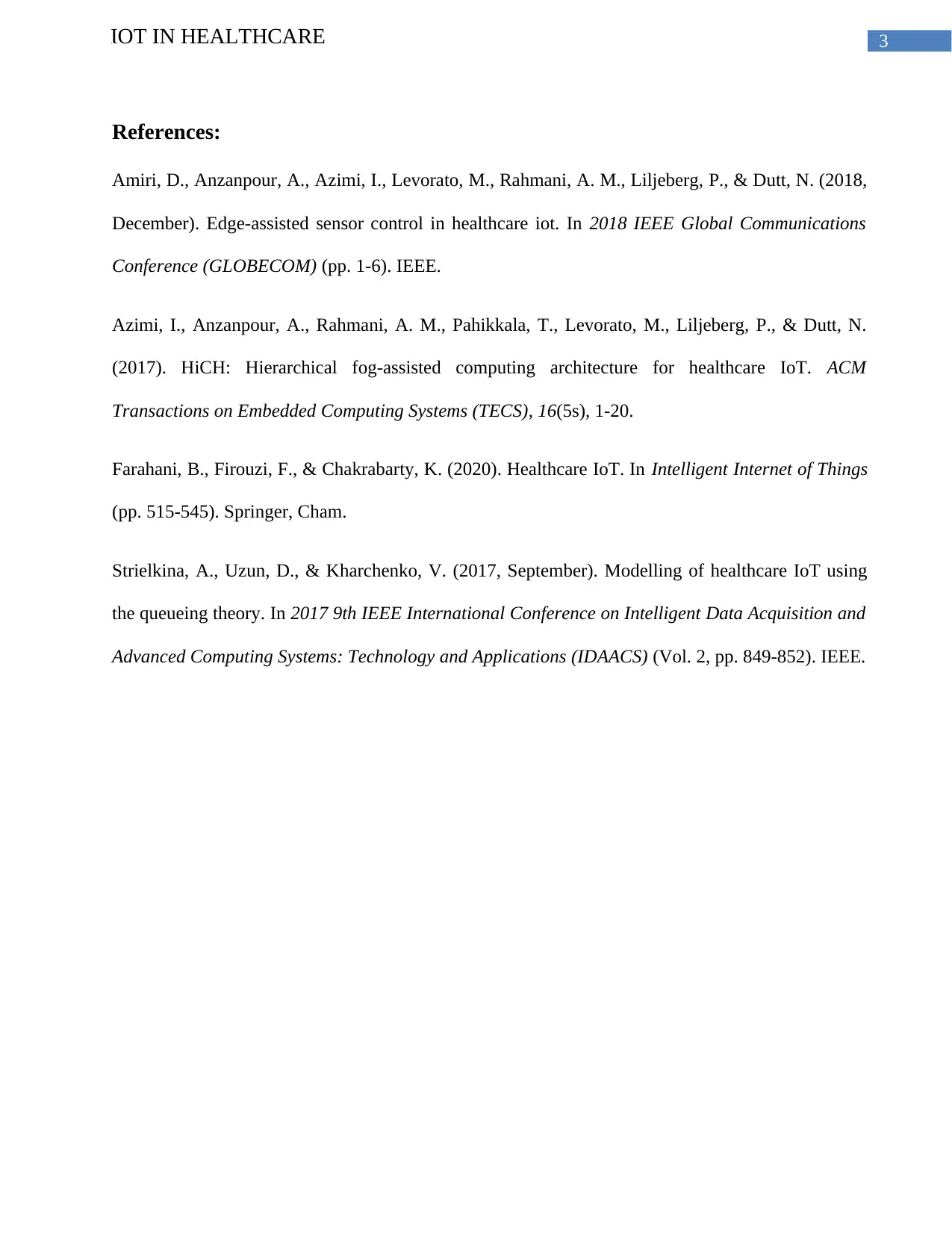IoT in Healthcare: Applications, Security Risks, and Solutions Report
VerifiedAdded on 2022/08/13
|4
|835
|26
Report
AI Summary
This report explores the implementation of IoT in healthcare, highlighting its potential to enhance medical center operations and improve patient treatments. It details the benefits, including real-time monitoring, affordability, data assessment, tracking, and remote assistance. The report also addresses the security risks associated with IoT in healthcare, such as data breaches and device vulnerabilities, emphasizing the importance of multi-factor authentication, data encryption, intrusion prevention systems, and security updates. The report references various research papers that support the findings and provide a comprehensive overview of the current state and future of IoT in the healthcare sector.

Running head: IOT IN HEALTHCARE
IOT in Healthcare
Name of the student:
Name of the university:
Author Note
IOT in Healthcare
Name of the student:
Name of the university:
Author Note
Paraphrase This Document
Need a fresh take? Get an instant paraphrase of this document with our AI Paraphraser

1IOT IN HEALTHCARE
Discussion on healthcare IoT:
The full implementation of IoT, from the area of healthcare is mutual hope since it permits
the medical centers to make functions in more competent manner and the patents in obtaining better
treatments. Through this healthcare method which is technology based unparalleled advantages are
there. This can enhance the efficiency and treatments and develop the patient’s healthcare
accordingly (Farahani, Firouzi & Chakrabarty, 2020).
Regarding benefits, it has simultaneous monitoring and reporting. The real-time monitoring
through different connected systems are able to save lives during medical emergencies such a
diabetes, heart failure and asthma attacks. Secondly, there are end-to-end affordability and
connectivity. It can automate the workflow of patient care through solutions of healthcare mobility
and additional technologies and the advanced healthcare facilities. Thirdly, there are data assortment
and assessment. There are huge data that is sent by healthcare systems and short time owing to real-
time applications are hard to sore and then manage as the access towards cloud is not present.
Fourthly, there are tracking and alerts. The systems collect important data and can transfer
information to doctors for the real-time tracking dropping notifications to people regarding critical
parts through mobile applications and additional connected systems. Next, there is the remote kind
of medical assistance. During emergency the patients could contact doctors at distant lace with smart
mobile applications (Azimi et al., 2017).
The healthcare applications consist of huge sensitive data like social security numbers,
medical histories and prescriptions. As the hackers get the data, they can steal identity of the victim
and resell dark over dark web. At particular situations. Attacker can have direct control on IoT
equipment resulting to lethal outcomes. The vulnerable devices are gateways towards secured
Discussion on healthcare IoT:
The full implementation of IoT, from the area of healthcare is mutual hope since it permits
the medical centers to make functions in more competent manner and the patents in obtaining better
treatments. Through this healthcare method which is technology based unparalleled advantages are
there. This can enhance the efficiency and treatments and develop the patient’s healthcare
accordingly (Farahani, Firouzi & Chakrabarty, 2020).
Regarding benefits, it has simultaneous monitoring and reporting. The real-time monitoring
through different connected systems are able to save lives during medical emergencies such a
diabetes, heart failure and asthma attacks. Secondly, there are end-to-end affordability and
connectivity. It can automate the workflow of patient care through solutions of healthcare mobility
and additional technologies and the advanced healthcare facilities. Thirdly, there are data assortment
and assessment. There are huge data that is sent by healthcare systems and short time owing to real-
time applications are hard to sore and then manage as the access towards cloud is not present.
Fourthly, there are tracking and alerts. The systems collect important data and can transfer
information to doctors for the real-time tracking dropping notifications to people regarding critical
parts through mobile applications and additional connected systems. Next, there is the remote kind
of medical assistance. During emergency the patients could contact doctors at distant lace with smart
mobile applications (Azimi et al., 2017).
The healthcare applications consist of huge sensitive data like social security numbers,
medical histories and prescriptions. As the hackers get the data, they can steal identity of the victim
and resell dark over dark web. At particular situations. Attacker can have direct control on IoT
equipment resulting to lethal outcomes. The vulnerable devices are gateways towards secured

2IOT IN HEALTHCARE
networks. Here, the hackers can utilize the IoT devices compromised for sneaking Ransomware and
additional kind of malware to network resulting disruption of services and prevent practitioner from
delivering any responsive type of treatment (Strielkina, Uzun & Kharchenko, 2017).
The potential strategies of mitigation involves the usage of multi-factor authentication. Here,
the multi-factor authentication makes the users to deliver more data than only username and
password. Through enabling this over the networks and devices, the hackers can have more difficult
time to access the mission-critical data. Then, there is the encryption of data that is another measure
to protect the business and patents from huge data breach. The encoding the records of electronic
health records as they are been transferred or left within the storage restricts the cyber-hackers from
stealing and reading sensitive data. Furthermore an intrusion prevention system can be installed
(Amiri et al., 2018). As maximum IoT attacks are provided through online, the intrusion prevention
systems are vital to determine and then block the unauthorized links to networks. It indicates the fact
the hackers must try to distantly access and shut down the IoT equipment to be stopped prior any
harm is done to the system. Moreover, there must be security updates. The manufacturers of IoT
releases various security patches occasionally for the gadgets. These updates are to be downloaded
as they are rolled out or the devices are to be permitted for automatically download and upgrade to
assure security from recent threats.
networks. Here, the hackers can utilize the IoT devices compromised for sneaking Ransomware and
additional kind of malware to network resulting disruption of services and prevent practitioner from
delivering any responsive type of treatment (Strielkina, Uzun & Kharchenko, 2017).
The potential strategies of mitigation involves the usage of multi-factor authentication. Here,
the multi-factor authentication makes the users to deliver more data than only username and
password. Through enabling this over the networks and devices, the hackers can have more difficult
time to access the mission-critical data. Then, there is the encryption of data that is another measure
to protect the business and patents from huge data breach. The encoding the records of electronic
health records as they are been transferred or left within the storage restricts the cyber-hackers from
stealing and reading sensitive data. Furthermore an intrusion prevention system can be installed
(Amiri et al., 2018). As maximum IoT attacks are provided through online, the intrusion prevention
systems are vital to determine and then block the unauthorized links to networks. It indicates the fact
the hackers must try to distantly access and shut down the IoT equipment to be stopped prior any
harm is done to the system. Moreover, there must be security updates. The manufacturers of IoT
releases various security patches occasionally for the gadgets. These updates are to be downloaded
as they are rolled out or the devices are to be permitted for automatically download and upgrade to
assure security from recent threats.
⊘ This is a preview!⊘
Do you want full access?
Subscribe today to unlock all pages.

Trusted by 1+ million students worldwide

3IOT IN HEALTHCARE
References:
Amiri, D., Anzanpour, A., Azimi, I., Levorato, M., Rahmani, A. M., Liljeberg, P., & Dutt, N. (2018,
December). Edge-assisted sensor control in healthcare iot. In 2018 IEEE Global Communications
Conference (GLOBECOM) (pp. 1-6). IEEE.
Azimi, I., Anzanpour, A., Rahmani, A. M., Pahikkala, T., Levorato, M., Liljeberg, P., & Dutt, N.
(2017). HiCH: Hierarchical fog-assisted computing architecture for healthcare IoT. ACM
Transactions on Embedded Computing Systems (TECS), 16(5s), 1-20.
Farahani, B., Firouzi, F., & Chakrabarty, K. (2020). Healthcare IoT. In Intelligent Internet of Things
(pp. 515-545). Springer, Cham.
Strielkina, A., Uzun, D., & Kharchenko, V. (2017, September). Modelling of healthcare IoT using
the queueing theory. In 2017 9th IEEE International Conference on Intelligent Data Acquisition and
Advanced Computing Systems: Technology and Applications (IDAACS) (Vol. 2, pp. 849-852). IEEE.
References:
Amiri, D., Anzanpour, A., Azimi, I., Levorato, M., Rahmani, A. M., Liljeberg, P., & Dutt, N. (2018,
December). Edge-assisted sensor control in healthcare iot. In 2018 IEEE Global Communications
Conference (GLOBECOM) (pp. 1-6). IEEE.
Azimi, I., Anzanpour, A., Rahmani, A. M., Pahikkala, T., Levorato, M., Liljeberg, P., & Dutt, N.
(2017). HiCH: Hierarchical fog-assisted computing architecture for healthcare IoT. ACM
Transactions on Embedded Computing Systems (TECS), 16(5s), 1-20.
Farahani, B., Firouzi, F., & Chakrabarty, K. (2020). Healthcare IoT. In Intelligent Internet of Things
(pp. 515-545). Springer, Cham.
Strielkina, A., Uzun, D., & Kharchenko, V. (2017, September). Modelling of healthcare IoT using
the queueing theory. In 2017 9th IEEE International Conference on Intelligent Data Acquisition and
Advanced Computing Systems: Technology and Applications (IDAACS) (Vol. 2, pp. 849-852). IEEE.
1 out of 4
Related Documents
Your All-in-One AI-Powered Toolkit for Academic Success.
+13062052269
info@desklib.com
Available 24*7 on WhatsApp / Email
![[object Object]](/_next/static/media/star-bottom.7253800d.svg)
Unlock your academic potential
Copyright © 2020–2025 A2Z Services. All Rights Reserved. Developed and managed by ZUCOL.





